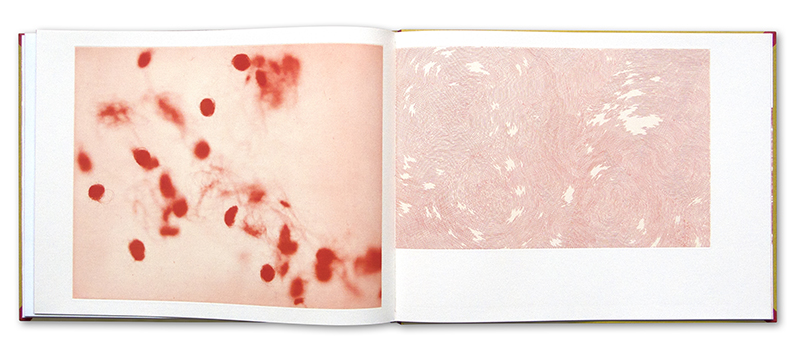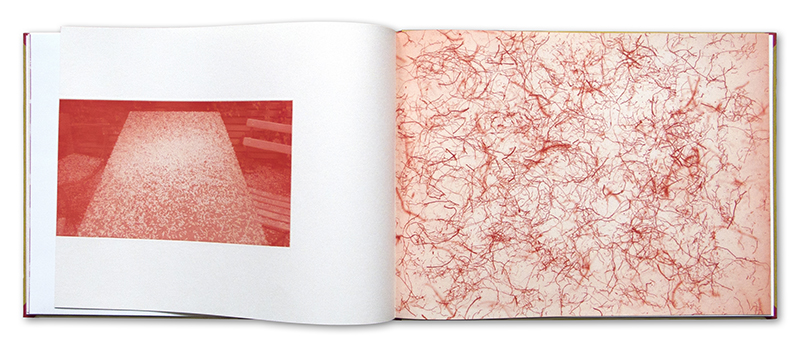ДА НЕТ, НАВЕРНОЕ
2014
With eleven heliogravures, two soft ground etchings on handmade Zerkall paper, 145 g/m2,
six fine art prints on Permajet Portfolio 220, two silk screen prints on clear transparent paper, 140 g/m2,
by Béatrice Gysin and a text by Konrad Tobler, 28.5 x 38 cm, 30 pages, bound, cover on Ingres paper,
120 g/m2.
Intaglio: Atelier de gravure AJAC, Moutier, Michèle Dillier and Arno Hassler.
Fine art prints: Fotolabor Pascale Brügger, Basel.
Silk screen prints: Druckerei in der Reithalle Bern, Jeanette Besmer.
Letterpress printing: Atelier de gravure AJAC, Moutier, Romain Crelier.
The hand-made binding was produced by Atelier für Grafik-, Foto- und Schriftgutrestaurierung Michael Rothe,
Bern.
Print run of 25 numbered copies.
Five additional artist copies not intended for sale bear the number EA I-V.
An edition was created in conjunction with the artist's book.
Other publications on Béatrice Gysin in Verlag Rothe Drucke: Hier stehen wir
Russian. Beatrice Gysin is passionate about learning Russian. It allows her to become immersed in an unfamiliar world where the certainties we take for granted in our mother tongue disappear. The title translates as follows: "Yes, no, perhaps, probably not". It might also be "Red".
Questions. Printing techniques are just one way of realising an image, however. They are a way of developing different forms of "image language", in turn creating visual textures that open up new worlds. These worlds are ambiguous – they are not to be understood but simply perceived, functioning as experiments that raise questions about how much we can know about the world. Yes, we decipher it – no, not really ... or perhaps we do after all?
Ciphers. The attempt to decipher the world takes us into fragile, magical spheres. The Romanticist Novalis evoked this in his unfinished novel "The Novices of Sais": "Mankind travels along manifold pathways. Anyone who pursues and compares these will perceive the emergence of certain strange figures that appear to be inscribed in that great ciphered text seen in everything: on birds' wings and eggshells, in clouds, in the snow, in crystalline and stone formations, in freezing waters, on the inside and outside of mountain ranges, plants, animals and human beings, on the stars in the sky, on fashioned and painted panes of pitch and glass, in the clustering of iron filings around a magnet and in the extraordinary ebb and flow of contingency. In these one may glimpse the key to this wondrous text, even the very rules of its grammar; and yet this intimation refuses to accommodate itself to fixed forms and appears to begrudge any translation into a higher key."
ДА НЕТ, НАВЕРНОЕ
2014
With eleven heliogravures, two soft ground etchings on handmade Zerkall paper, 145 g/m2, six fine art prints on Permajet Portfolio 220, two silk screen prints on clear transparent paper, 140 g/m2, by Béatrice Gysin and a text by Konrad Tobler, 28.5 x 38 cm, 30 pages, bound, cover on Ingres paper, 120 g/m2.
Intaglio: Atelier de gravure AJAC, Moutier, Michèle Dillier and Arno Hassler. Fine art prints: Fotolabor Pascale Brügger, Basel. Silk screen prints: Druckerei in der Reithalle Bern, Jeanette Besmer. Letterpress printing: Atelier de gravure AJAC, Moutier, Romain Crelier. The hand-made binding was produced by Atelier für Grafik-, Foto- und Schriftgutrestaurierung Michael Rothe, Bern.
Print run of 25 numbered copies. Five additional artist copies not intended for sale bear the number EA I-V.
An edition was created in conjunction with the artist's book. Other publications on Béatrice Gysin in Verlag Rothe Drucke: Hier stehen wir
From the text by Konrad Tobler:
Russian. Beatrice Gysin is passionate about learning Russian. It allows her to become immersed in an
unfamiliar world where the certainties we take for granted in our mother tongue disappear. The title translates as follows:
"Yes, no, perhaps, probably not". It might also be "Red".
Questions. Printing techniques are just one way of realising an image, however. They are a way of developing
different forms of "image language", in turn creating visual textures that open up new worlds. These worlds are ambiguous –
they are not to be understood but simply perceived, functioning as experiments that raise questions about how much we can
know about the world. Yes, we decipher it – no, not really ... or perhaps we do after all?
Ciphers. The attempt to decipher the world takes us into fragile, magical spheres. The Romanticist Novalis evoked
this in his unfinished novel "The Novices of Sais": "Mankind travels along manifold pathways. Anyone who pursues and compares
these will perceive the emergence of certain strange figures that appear to be inscribed in that great ciphered text seen in
everything: on birds' wings and eggshells, in clouds, in the snow, in crystalline and stone formations, in freezing waters,
on the inside and outside of mountain ranges, plants, animals and human beings, on the stars in the sky, on fashioned and
painted panes of pitch and glass, in the clustering of iron filings around a magnet and in the extraordinary ebb and flow of
contingency. In these one may glimpse the key to this wondrous text, even the very rules of its grammar; and yet this
intimation refuses to accommodate itself to fixed forms and appears to begrudge any translation into a higher key."






